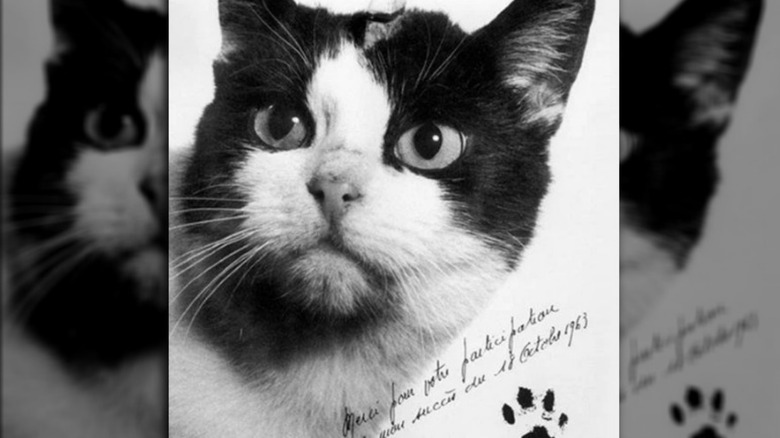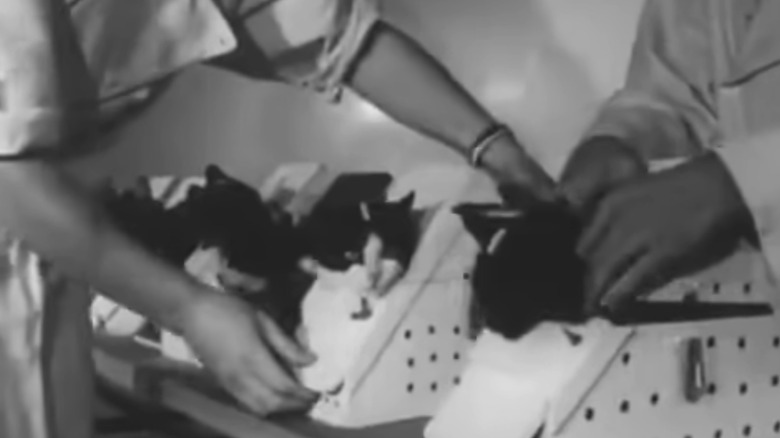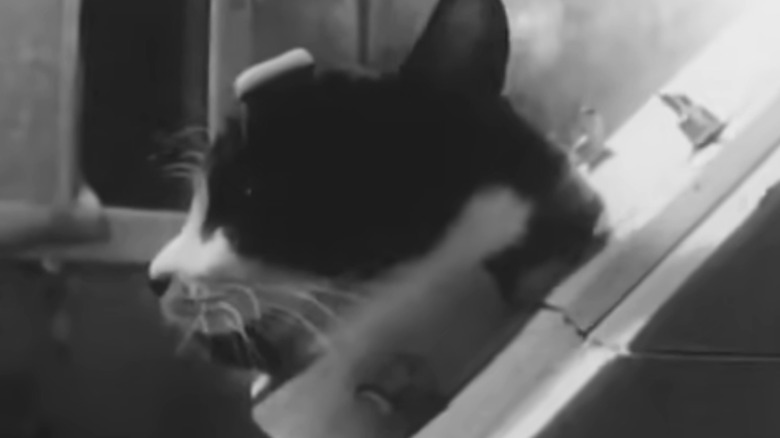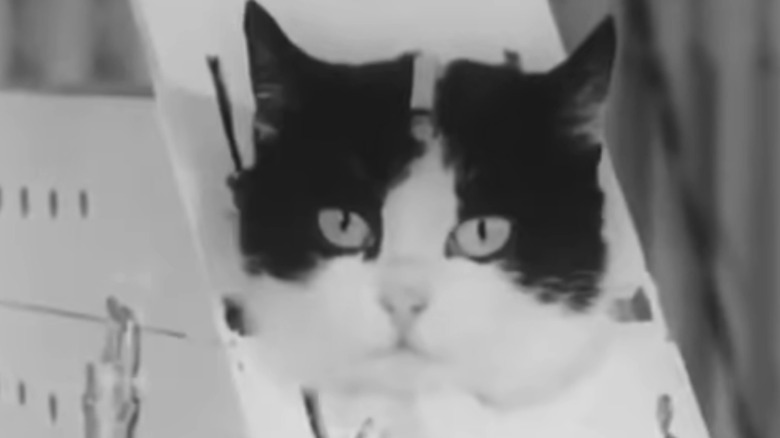The Untold Truth Of Felicette, The Only Cat Sent To Space
In Earth's long history, only a few living creatures have made it off the surface of the planet and into the vastness of space. Of these creatures, humans generally receive the most attention. Per WorldSpaceFlight, nearly 600 humans have been in space — a miniscule fraction of our total population. After human space travelers, you may sometimes hear about space monkeys, or even space dogs. (The first animal to orbit the Earth was, famously, a Soviet dog named Laika.) But what about cats?
If you haven't heard much about space cats, we don't blame you. As it turns out, throughout the entire history of spaceflight, only one cat has been successfully launched into space: a black-and-white female named Félicette.
Félicette's momentous launch occurred during the height of the space race in October 1963. Naturally, then, you'd probably guess that Félicette was launched by either the United States or the Soviet Union, the two main scientific and military powers behind the space race. But no; as her name hints, Félicette was actually launched by the space program of France.
If you're familiar with the history of animals in space, you'll know that most of these stories don't end well. Laika, for instance, died of overheating just a few hours into her flight, per Smithsonian Magazine. Félicette, on the other hand, had a successful mission; the cat landed safely on Earth after her brief flight into space. But that still doesn't mean that this story has a happy ending.
The French space program chose Félicette for her temperament and size
While the United States and the Soviet Union operated the dominant space programs of the 20th century, other countries sought to advance space research as well. Somewhere around third place in this extended "race" was the French space program. France got its start launching animals into space with a series of rats in the early 1960s, per the Smithsonian Magazine. But, to better study the effects of spaceflight on the body and brain, France's scientists decided to move on to a bigger mammal: cats.
In 1963, France's Centre d'Enseignement et de Recherches de Médecine Aéronautique (CERMA) obtained 14 cats from a pet dealer. French Slate reports that, over the course of several months, these cats underwent a number of trials similar to human astronaut trainees. The cats were forced to grow accustomed to confined spaces, and even sent to a spinning chair to get used to rocket-like conditions. Throughout the training, each cat also had to live with electrodes implanted into their brain; these allowed the scientists to collect neurological data.
Ultimately, the French scientists narrowed down the candidates to a group of six cats with calm temperaments and appropriate weights for launch. Among these, Félicette became the chosen one. At the time, however, "Félicette" was not her name; France's scientists avoided naming the cats so they would not grow too attached to them, per Slate. So, when her launch date arrived, Félicette was known only as "C341."
Félicette was successfully launched into space on October 18, 1963
According to Space.com, Félicette's successful space launch occurred on October 18, 1963. That's two years after the U.S. and USSR had begun sending humans into space. Félicette was boarded onto a liquid-fueled Véronique AG1, a state-of-the-art rocket at the time. That rocket launched in the early morning from a site in Algeria's Sahara desert, Gizmodo states.
The whole trip lasted under 15 minutes. Unlike Laika, who was sent into orbit around the Earth, Félicette was simply sent for a brief sojourn to the edge of space and back. Still, it was certainly the most dramatic 15 minutes of Félicette's life. Per Space.com, Félicette reached a maximum height of nearly 100 miles, and experienced around 9.5 g's of acceleration. (The average human will pass out after just 4 or 5 g's, according to New Scientist.) The whole time, the electrodes attached to Félicette's brain allowed CERMA scientists to study her vitals and examine how spaceflight affected her mind. After a few minutes of weightlessness, Félicette's capsule began its descent to Earth. The capsule's parachutes ensured a soft landing, and Félicette was recovered safe and sound.
One week after Félicette's flight, the French space program attempted to launch another cat from her cohort, NASA reports. Unfortunately, the rocket malfunctioned, and that cat died. France soon abandoned its feline space program, but moved on to launching monkeys a few years later.
Two months after her launch, Félicette was euthanized so researchers could study her brain
This sounds like a story with a happy ending, right? Unlike many other space-faring animals, Félicette returned to Earth safely. Félicette did spend several months as a national icon. In fact, per French Slate, it was the media who named her "Félicette" — no doubt a reference to the famous cartoon character "Felix the Cat." Félicette would go on to appear on stamps, postcards, and much more.
But just two months after her successful launch, Félicette was euthanized by CERMA scientists. Per Smithsonian, despite collecting plenty of useful data from Félicette's electrodes during her flight, France's scientists wanted more information about how spaceflight had affected her brain, so they killed her in order to examine it.
Sometime after this, Félicette's status as the first cat in space faded from the media's attention — even in France. But in 2017, a Kickstarter campaign successfully raised $57,000 to create a bronze statue of Félicette, per Space.com. In 2020, that memorial statue was officially unveiled at the International Space University in Strasbourg, France. The statue depicts Félicette sitting on a globe, gazing up at the stars.
Today, Félicette remains the first and only cat successfully sent to space. With a renewed interest in space travel in recent years, it's hard to imagine that Félicette will be the last. Let's hope that the next generation of space cats have happier fates than Félicette.



